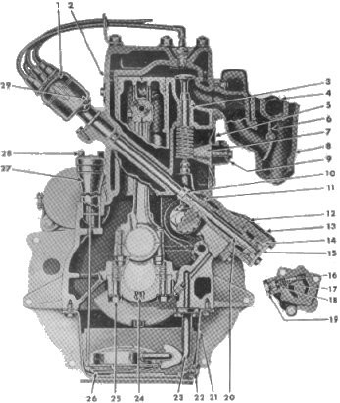
• Shift the lever into the reverse position, slowly release the clutch pedal and regulate the car speed with the foot
accelerator.
TO USE THE ENGINE AS A BRAKE.
The most effective brake for holding the vehicle back on a steep grade is the engine. To use the engine as a brake, shift into
one of the lower speeds before starting to descend. Keep the clutch engaged, the throttle closed, and the ignition “ON”. Low
gear will hold any vehicle effectively on any hill it can climb.
Never engage the clutch suddenly when the vehicle is coasting with the clutch released and the transmission gears in mesh, as
damage to the driving mechanism may result.
FIG. 4 -- END SECTIONAL VIEW OF ENGINE
1. Ignition Distributor
2. Cylinder Head Gasket
3. Eshaust Valve Guide
4. Intake Manifold Assembly
5. Valve Spring Cover Assembly
6. Heat Control Valve
7. Crankcase Ventilator Baffle
8. Exhaust Manifold Assembly
9. Crankcase Ventilator Assembly
10. Distributor Shaft Friction Spring
11. Oil Pump Driven Gear
12. Oil Pump Gasket
13. Oil Pump Assembly
14. Oil Pump Pinion
15. Oil Pump Cover aft
16. Oil Pump Relief Plunger
17. Oil Pump Relief Plunger Spring
18. Oil Pump Relief Plunger
Shim
19. Oil Pump Relief Plunger
Spring Retainer
20. Oil Pump Sh21. Oil Pan
Assembly
22. Oil Pan Drain Plug
23. Oil Float Support
24. Crankshaft Bearing Dowel
25. Crankshaft Bearing Cap to
Crankcase Screw
26. Oil Float Assembly
27. Oil Filler Tube
28. Oil Filler Cap and Level
Indicator
29. Distributor Oiler
STARTING VEHICLE ON UPGRADE.
In starting on an upgrade, hold the vehicle with the hand brake, disengage the clutch and shift the transmission into low speed,
then accelerate the engine with the foot accelerator in the regular way while simultaneously releasing the hand brake and
engaging the clutch
SHIFTING GEAR IN TRANSFER CASE.
The transfer case is essentially a two speed transmission, which provides a low and a direct gear and also a means of
connecting the engine power to the front axle. It is an auxiliary unit attached to the rear of the standard transmission.
Control of the transfer case is through the two shift levers, Fig. 1 No. 19 and No. 20. The left lever, No. 20, is used to connect
and disconnect the power to the front axle. The right lever, No. 19 is used to shift the transfer case gears to secure either
“High” (direct drive) or a very low gear ratio for heavy pulling requirements.
Instructions for shifting gears in the transfer case are as follows: See Fig. 3.
1. To engage front axle drive, depress the clutch pedal, release accelerator and move the left hand shift lever (No. 20) to
rear position
2. With the front axle drive engaged, the right hand lever (No. 19) may be shifted to the rear into “High” (direct) or
forward into “Low”. The “Neutral” position midway between “High” and “Low” is for use when the power take-off belt
drive is used. The vehicle cannot be driven when this lever is in “Neutral”.
3. To disengage the front axle drive, depress the clutch pedal, release the accelerator and shift the left lever to the forward
position. The transfer case can be operated only in “High” (direct drive) when the front axle drive is disengaged.
4. Shifting from high to low transfer case gear should not be attempted except when the vehicle is practically at a
standstill. The front axle drive must be engaged for this shift. Release the accelerator and depress the clutch pedal – move
the left hand shift lever to the rear position to engage the front wheel drive, then move the right hand shift lever to forward
position (low transfer case gear).
5. Shifting from low to high transfer case gear may be accomplished at any time, regardless of vehicle speed. Release
accelerator and depress clutch pedal and shift right hand lever into rear position.
USE OF FOUR WHEEL DRIVE.
The “Universal Jeep” is equipped with four-wheel drive and transfer case to provide additional traction and a low gear ratio for
use on difficult terrain and to provide low speed pulling power for industrial and agricultural use. Four-wheel drive should be
used only when greater traction and power are required than provided by the standard transmission and low gear.
Avoid the use of four-wheel drive on hard surfaced highways as it will result in rapid tire wear and hard shifting of the transfer
case gears. Should hard shifting occur, disengage the clutch, start engine, shift the transmission into reverse gear, back the
vehicle a few feet, and disengage the clutch. If transfer case is in low range, shift into high, then disengage front axle drive (left
lever forward).


















